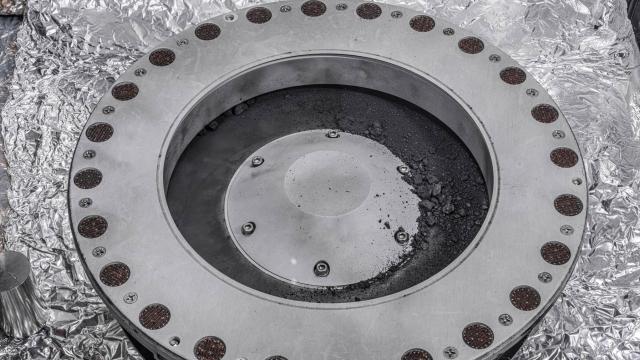About a month ago, pristine samples from an asteroid landed on Earth while enclosed within a tight capsule. The sample canister was designed to keep the main chunk of the asteroid safe during its journey through space, but now teams at NASA’s Johnson Space Center (JSC) are struggling to open it to get at the space rocks.
For the past week, the curation team for the OSIRIS-REx mission has been having a hard time opening the TAGSAM head, a round sampler head at the end of an articulated arm on the spacecraft that was used to grab the sample from the asteroid. The TAGSAM head (Touch-and-Go Sample Acquisition Mechanism) is where the bulk of the asteroid sample is, and it is therefore being carefully handled by members of the team through a specialized glovebox under the flow of nitrogen to prevent contamination.
“After multiple attempts at removal, the team discovered two of the 35 fasteners on the TAGSAM head could not be removed with the current tools approved for use in the OSIRIS-REx glovebox,” NASA wrote in a blog post on Friday. “The team has been working to develop and implement new approaches to extract the material inside the head, while continuing to keep the sample safe and pristine.”
When the aluminum lid to the sample canister was first removed, the mission team found black dust and debris on the avionics deck of the canister. On October 11, NASA revealed the first look at the samples collected from the outside of the TAGSAM head while adding that it still hasn’t opened the sample canister yet. “The only problem is a great problem and that’s we’ve found a lot more sample than we’re anticipating before even getting into the TAGSAM,” Francis McCubbin, curator at NASA’s JSC, said during a live event.
As it turns out, there’s also a not-so-good problem. So far, the curation team has managed to remove some of the material from inside the canister with tweezers or a scoop while holding down the TAGSAM head’s mylar flap. Over the next few weeks, the team will try to come up with new ways to extract the rest of the sample.
“The tools for any proposed solution to extract the remaining material from the head must be able to fit inside the glovebox and not compromise the scientific integrity of the collection, and any procedures must be consistent with the clean room’s standards,” NASA wrote in its blog post.
The asteroid samples extracted so far, however, exceed the mission’s goal of collecting 60 grams of debris from the asteroid, according to NASA. To date, the space agency has recovered 2.48 ounces (70.3 grams) of rocks and dust. The team behind the mission has also gotten a head start in analyzing the samples and found an abundance of carbon and water molecules. Scientists were hoping to find evidence of organic matter embedded within the asteroid sample as it supports the theory that the building blocks of life hitch-hike their way through the universe aboard these ancient space rocks.
The OSIRIS-REx mission launched in September 2016 and reached asteroid Bennu in December 2018. After nearly two years of observations, the spacecraft landed on Bennu and snagged a sample from its surface in October 2020. OSIRIS-REx dropped off the asteroid samples in the Utah desert on September 24.
The mission may have recently hit a (hopefully temporary) snag, but early findings from the asteroid sample have proven to be quite promising so hopefully the remaining bits of the space rock make it out of that canister soon.
